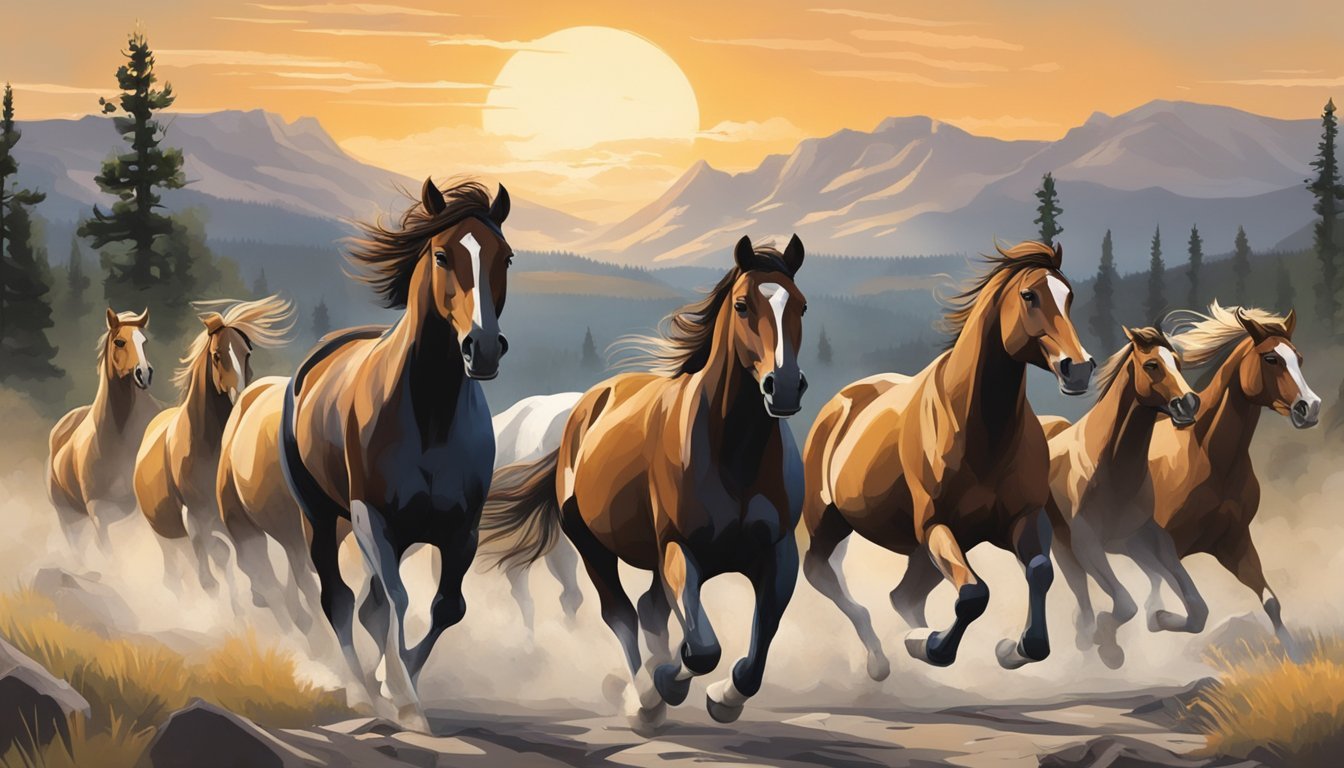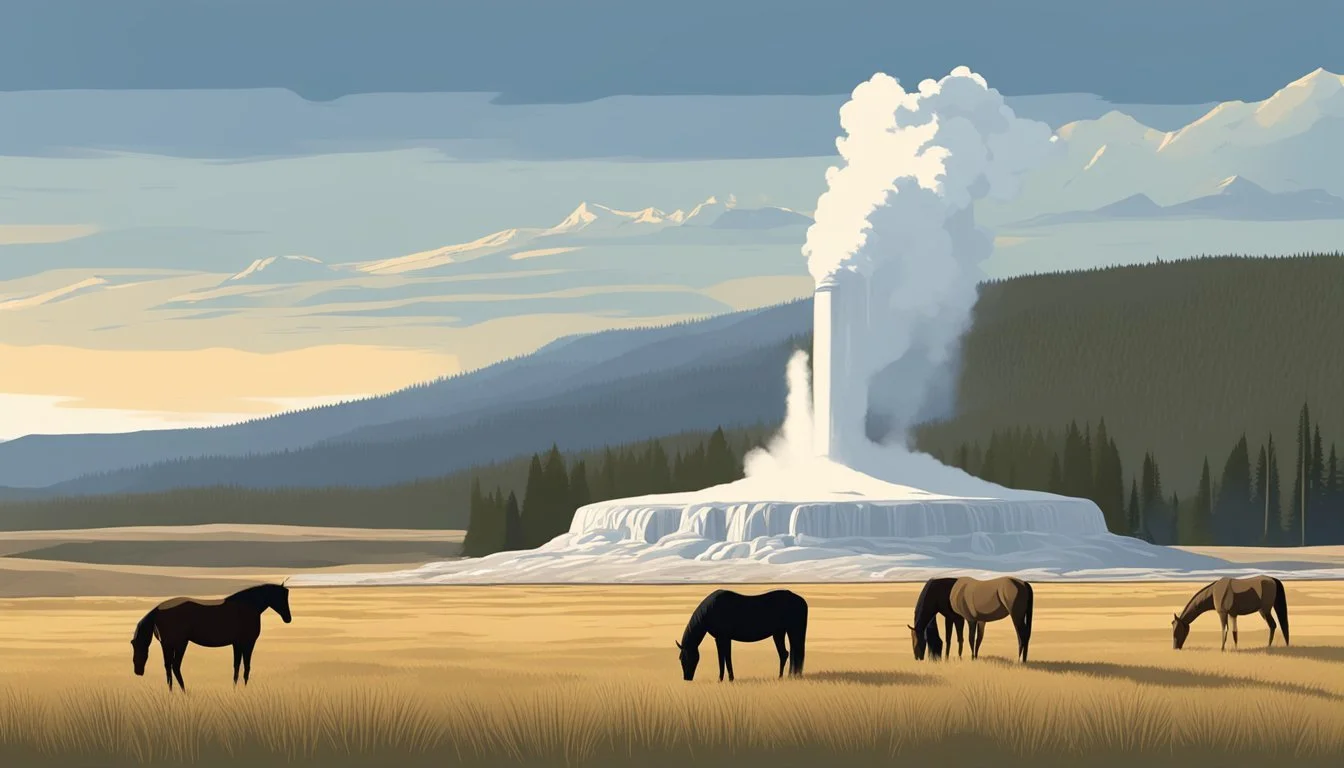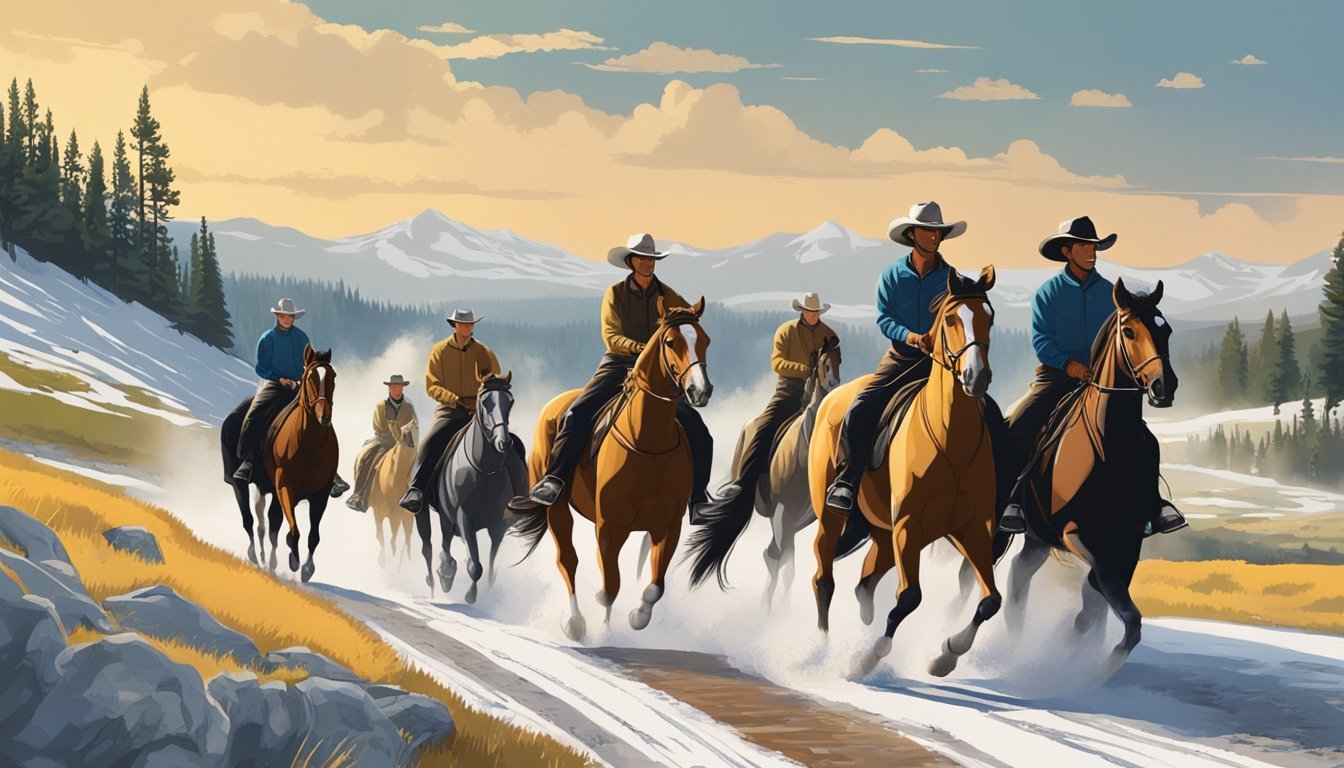Meet the Majestic Stars: Yellowstone Show Horses Bring Cowboy Culture to Life!
The hit TV series Yellowstone captivates audiences with its gripping portrayal of ranch life in Montana. While the Dutton family's drama takes center stage, the show's equine stars play a crucial role in bringing the cowboy culture to life. The horses featured in Yellowstone are not just props but talented performers in their own right, many with impressive show records and reining championships.
Taylor Sheridan, the show's creator, brings authenticity to the screen by incorporating real working horses. Metallic Cat, a renowned American Quarter Horse, made an appearance in season 3. Other equine stars include Walla Walla Starbuck and High-Class Trash, both accomplished reining horses with significant earnings in competitions.
These horses add depth to the characters' experiences, showcasing the strong bond between cowboys and their mounts. From Kevin Costner's John Dutton to the ranch hands, the interactions with these magnificent animals highlight the importance of horsemanship in ranch life. The Yellowstone horses embody the spirit of the American West, bringing an extra layer of realism to the show's depiction of modern cowboy culture.
The Significance of Horses in Yellowstone
Horses play a pivotal role in the Yellowstone series, shaping characters, driving plot points, and representing the spirit of the American West. These majestic animals are integral to the show's authentic portrayal of ranch life and cowboy culture.
Roles and Representation
Horses in Yellowstone embody power, freedom, and the rugged beauty of Montana's landscape. They serve as essential tools for ranching operations, enabling characters to manage vast territories and herd cattle efficiently. The series showcases various equestrian disciplines, including cutting, reining, and ranch work.
Cutting horses display remarkable agility in separating cattle from the herd. Reining horses demonstrate precise control and athleticism in competition scenes. Ranch horses exhibit stamina during long rides and cattle drives, highlighting their versatility and importance in daily ranch operations.
These equine characters often mirror their human counterparts, reflecting personality traits and story arcs. The bond between rider and horse is frequently explored, emphasizing themes of trust, loyalty, and partnership.
Breed Selection and Characteristics
Yellowstone primarily features American Quarter Horses, known for their versatility and cow sense. These horses excel in various disciplines showcased in the series, from cutting and reining to ranch work.
The show's creators carefully select horses that embody the ideal characteristics for each role. Cutting horses display quick reflexes and low-set haunches for rapid direction changes. Reining horses exhibit smooth gaits and responsive steering for intricate maneuvers.
Ranch horses in the series showcase endurance, sure-footedness, and calm temperaments - traits essential for long days of work in challenging terrain. The diversity of coat colors and markings adds visual interest and helps distinguish individual horses.
Notable Horses in the Series
Several horses in Yellowstone have gained recognition for their performances and real-world accomplishments. Metallic Cat, a champion cutting horse, appears in key scenes demonstrating the precision of separating cattle.
Walla Walla Starbuck, a red dun stallion owned by Taylor Sheridan, features in Season 1. This horse boasts impressive reining credentials with over $50,000 in National Reining Horse Association earnings.
High-Class Trash, another reining champion, makes appearances throughout the series. Other notable equine cast members include Custom Made Gun, Lil Joe Cash, and Dun It Chexinic.
These horses not only enhance the show's authenticity but also showcase the real-world talent and training behind Yellowstone's equestrian scenes. Their inclusion bridges the gap between fiction and the genuine ranching heritage that inspires the series.
Equestrian Competitions and Training
The Yellowstone TV series showcases various equestrian disciplines and training methods central to ranch life. These elements reflect the show's commitment to authenticity in portraying Western horse culture.
Cutting and Reining Disciplines
Cutting and reining are two prominent disciplines featured in Yellowstone. Cutting involves separating a single cow from a herd, showcasing a horse's agility and cow sense. Reining demonstrates a horse's responsiveness through precise movements like spins and sliding stops.
The show features real-life champions in these events. Metallic Cat, Dun It Chexinic, and Walla Walla Starbuck are some of the accomplished reining horses that appear on screen. These equine athletes bring authenticity to the competitive scenes.
Quarter Horses are the breed of choice for both disciplines due to their athleticism and cow sense. Their muscular build and quick reflexes make them ideal for the sharp turns and sudden stops required in cutting and reining.
Training Techniques and Trainers
Yellowstone incorporates genuine training methods used by top professionals in the industry. The show's creator, Taylor Sheridan, brings in real trainers to ensure accuracy in horse handling scenes.
Andrea Fappani, Todd Bergen, and Bob Avila are among the respected trainers who have lent their expertise to the show. These professionals use progressive training techniques that build trust between horse and rider.
Training often begins with groundwork to establish respect and communication. Riders then progress to more advanced maneuvers, always prioritizing the horse's understanding and willingness to perform.
Prominent Competitions
The series highlights major equestrian events that are significant in the Western horse world. The National Cutting Horse Association (NCHA) and National Reined Cow Horse Association (NRCHA) organize some of the most prestigious competitions.
The NRCHA Snaffle Bit Futurity is a pinnacle event for young horses in the reined cow horse discipline. It tests a horse's versatility in reining, cutting, and working cow horse events.
The World's Greatest Horseman competition showcases the most well-rounded horses and riders. Contestants must excel in herd work, rein work, steer stopping, and cow work.
These events offer substantial prize money, reflecting the economic importance of horse breeding and training programs to ranches like the fictional Yellowstone.
Historical Connections
Yellowstone's depiction of horses and ranching draws deeply from the American West's rich history. The show intertwines past and present, highlighting how historical events shape modern ranch life.
Yellowstone and the Dutton Ranch
The Dutton Ranch serves as a living link to Montana's ranching heritage. Founded in the late 19th century, it represents the enduring legacy of pioneer families who settled the West. The ranch's horses embody this connection, with bloodlines tracing back to early American breeds. These equines reflect generations of selective breeding for traits valued in ranch work - strength, stamina, and intelligence.
John Dutton's commitment to preserving the ranch mirrors real-life efforts to maintain traditional ranching practices. His character epitomizes the cowboy ethos of hard work, self-reliance, and deep respect for the land and animals.
Influence of Past Events
Historical events like the 1883 westward expansion and early 20th-century developments shape Yellowstone's narrative. The show references these periods through flashbacks and family lore, illustrating how past decisions impact present-day ranch operations.
The series portrays the evolution of ranching techniques and horse management. It contrasts traditional methods with modern challenges, such as land development pressures and changing economic landscapes. This juxtaposition highlights the struggle to maintain a cowboy lifestyle in a rapidly changing world.
Yellowstone's horses symbolize continuity amidst change, bridging historical ranching practices with contemporary realities. Their presence on screen serves as a constant reminder of the enduring bond between humans and horses in Western culture.
Popular Culture and Impact
Yellowstone has ignited a renewed fascination with Western culture and equestrianism. The show's portrayal of ranch life and horsemanship has resonated deeply with viewers, influencing both popular culture and the equine industry.
The Cultural Phenomenon of Yellowstone
Yellowstone, airing on Paramount Network, has become a cultural touchstone. The series, created by Taylor Sheridan, stars Kevin Costner as John Dutton, the patriarch of a powerful ranching family in Montana.
The show's depiction of cowboy culture and the American West has captivated audiences. Characters like Rip Wheeler and Beth Dutton have become household names.
Yellowstone's success has sparked a renewed interest in Western fashion, with viewers emulating the characters' style. The series has also boosted tourism in Montana, with fans eager to experience the landscapes showcased in the show.
Crossover with Real-World Equestrianism
Yellowstone's impact extends beyond entertainment into the equine industry. The show's focus on skilled horsemanship has increased interest in Western riding disciplines.
The American Quarter Horse, prominently featured in Yellowstone, has seen a surge in popularity. The American Quarter Horse Association (AQHA) has reported increased membership and event participation.
Real-world ranches like the Four Sixes (6666) have gained attention due to their association with the show. The series has showcased elite cutting horses, including Metallic Cat, raising awareness of cutting as a sport.
Yellowstone's influence has reached competitive equestrianism, with more riders participating in events sanctioned by organizations like the National Reined Cow Horse Association (NRCHA).
Economic Aspects
The hit series Yellowstone has sparked significant economic ripples, influencing both the equine industry and local economies. Horses play a central role in the show's portrayal of ranch life, shaping viewer perceptions and market trends.
The Horse Industry in Television
Yellowstone's popularity has boosted interest in Western-style riding and horse ownership. Demand for Western riding horses has increased, particularly on the East Coast. The show features accomplished reining horses like Walla Walla Starbuck and High-Class Trash, both with impressive lifetime earnings. These equine stars showcase the value of well-trained horses in competitive circuits.
Yellowstone's authentic depiction of horsemanship has elevated public awareness of equestrian skills. This heightened interest translates to increased participation in riding lessons, horse shows, and equine-related tourism activities.
The Influence on Local Economies
Montana, where Yellowstone is set, has seen a surge in tourism and real estate interest. The show's stunning portrayal of ranch life and Montana's landscapes attracts visitors eager to experience the Dutton Ranch lifestyle.
Local businesses benefit from increased tourism, with hotels, restaurants, and outdoor recreation companies seeing upticks in revenue. The real estate market has also felt the "Yellowstone effect," with growing interest in ranch properties and rural land.
Film production itself brings economic benefits. Crews spend money on local goods and services, creating jobs and stimulating regional economies. The show's success has sparked interest in Montana as a filming location, potentially attracting more productions to the area.
Characters and Their Equine Partners
The Yellowstone TV show portrays deep bonds between its characters and their horses. These relationships reveal important aspects of personalities and drive key plot developments.
Key Characters and Their Relationships with Horses
John Dutton, played by Kevin Costner, frequently rides his trusty horse while overseeing ranch operations. His skilled horsemanship reflects his strong connection to the land and traditional ranching lifestyle.
Beth Dutton demonstrates her fierce independence through her confident riding, often galloping across the ranch to clear her head. Rip Wheeler's gentle way with horses contrasts his tough exterior, hinting at his softer side.
The show depicts characters facing challenging rides and breaking in new horses. These scenes parallel their personal struggles and conflicts threatening the ranch.
Character Development Through Horsemanship
Characters' interactions with horses reveal important traits and drive their growth. John Dutton's patient training of young horses mirrors his mentorship of ranch hands and family members.
Rip's ability to calm spooked horses showcases his leadership skills and emotional intelligence. This transfers to his role managing the bunkhouse and supporting Beth.
Beth's fearless riding style reflects her bold approach to business and family matters. Her growing bond with a particular horse tracks her journey of healing and self-discovery.
The commitment required to care for horses parallels characters' dedication to preserving the Dutton legacy and way of life.




